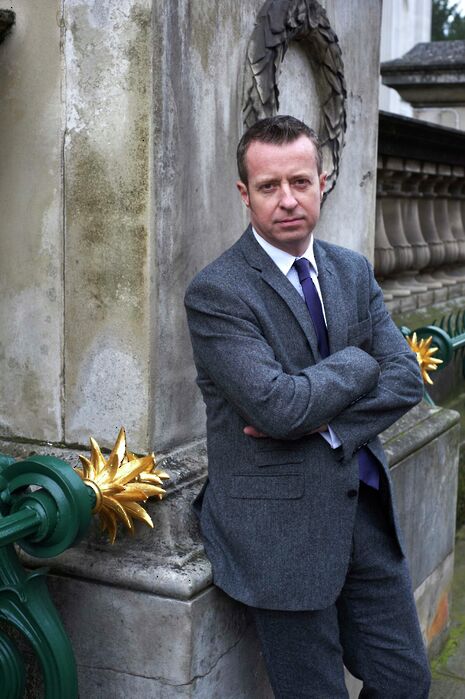Interview: Tim Knox
Shefali Kharabanda speaks to Tim Knox, the Director of the Fitzwilliam Museum, about heading up a 200 year-old institution

If you ask a young boy what they want to be when they grow up, it’s likely that the answer won’t be curator of a museum. But if you travelled back in time and met a very young Tim Knox, that’s what you’d get. He skipped out on the astronaut phase.
Knox’s enthusiasm for art began at an early age. He grew up in Nigeria, and then in Fiji. If his parents would go into town to do shopping, Tim would be waiting in the museum. He became obsessed with historic houses, churches, old buildings and collected little things, like shells and insects. He was fascinated with both the large and grandiose and the small and delicate: These passions shaped his career. After studying art history at the Courtauld Institute, Tim Knox worked at the Royal Institute of British Architects Drawings Collection, the National Trust, and then ran the Soane Museum for eight years before moving to the Fitzwilliam Museum in 2013.
I bring up Carl Winters’s words in his interview with Varsity in 1966. What would students miss out on if they spent their undergraduate years without setting foot in the place? Cambridge has so many different forms of art on offer and creative endeavours filling our calendars each week. We are, Knox acknowledges, rather spoilt for choice.
After much consideration, he says: “If universities are here to polish people and equip them for the outside world, the university museum has actually a very important place.” It’s difficult not to agree. For those of us furiously scribbling away at essays on a regular basis, the openness and calmness of the Museum gift art, paired with an endless amount of time to reflect, consider and breathe.
He talks about the role of the Fitzwilliam as “Janus-headed”. On the one hand, they have to support university research, and on the other, to cater for the general populace. It leads us on nicely to talk about access, and the interesting dynamic in Cambridge between students, university staff, and those “who aren’t involved in the rather rarified groves of academe”. He’s keen to establish responsibility among them: “You know, there are sections of the populace who live in North Cambridge or in The Fens who wouldn’t dream of coming into central Cambridge, let alone go inside a museum. They find it completely intimidating, and quite a lot of work in our learning teams is to encourage people to see this as part of their lives as well. That’s as important, in a way, as our work with the university, to bridge that gap.” Exhibitions play an important role in this, engendering excitement and broadening what the museum has to offer. He mentions the upcoming exhibition Death on the Nile, showcasing Egyptian coffins, which he believes could be inviting for people not necessarily interested in paintings by Titian and Matisse. “Certainly the small boy population of Cambridge will be very interested”, he says, smiling. I realise, as we speak, how much the accessibility of museums has developed over time. “In the last 10 or 20 years”, he says, “museums have completely transformed themselves”. It’s something going on all over the world, he says, “but certainly we’re leading in Britain, trying to make museums relevant to modern audiences”, gesturing to the importance at the Fitzwilliam of emphasising free entry and friendly staff, as well as mentioning the significance of disabled access, lifts and baby-changing facilities. Famously, the nineteenth-century museum refused to allow in servants, babies, and nursemaids with their charges, preferring those who were deemed ‘respectable’.
I question Tim about the extent of sincerity in art. On Picasso, he says: “those early works done as a penniless artist in Paris, or Guernica, done on the eve of the Second World War – I would say that absolutely comes from the heart. This is an impassioned cry from a Spaniard looking at this terrible atrocity that falls on his Catalan countrymen.” Yet Knox also acknowledges how art can be manufactured by the mind for particular purposes. “Certainly as a grand old man in the Sixties, Picasso was perfectly capable of turning out pot boilers for money.” According to Knox, this can be seen again and again with artists. He talks about Millais, starting off as an ardent pre-Raphaelite painting incredibly meticulous works which were “hated by the critics, hated by them”. He later became very wealthy, became a baronet, and paints Bubbles. Pears soap bought Bubbles and used it to advertise.
Perhaps there is no empirical evidence to prove the honesty of a piece of work. And there doesn’t need to be. There is no training needed to appreciate sincerity. If it’s there, you feel it. Tim Knox is certainly as sincere in his responses as he is in his concern that the Fitzwilliam be accessible and frequented by everyone, irrespective of who they are or where they come from. His lifelong passion for architecture, art of all forms, and interesting objects is palpable, and you don’t need to be an art historian to feel it.
 News / Fitz students face ‘massive invasion of privacy’ over messy rooms23 April 2024
News / Fitz students face ‘massive invasion of privacy’ over messy rooms23 April 2024 News / Cambridge University disables comments following Passover post backlash 24 April 2024
News / Cambridge University disables comments following Passover post backlash 24 April 2024 Comment / Gown vs town? Local investment plans must remember Cambridge is not just a university24 April 2024
Comment / Gown vs town? Local investment plans must remember Cambridge is not just a university24 April 2024 Interviews / Gender Agenda on building feminist solidarity in Cambridge24 April 2024
Interviews / Gender Agenda on building feminist solidarity in Cambridge24 April 2024 Comment / Does Lucy Cavendish need a billionaire bailout?22 April 2024
Comment / Does Lucy Cavendish need a billionaire bailout?22 April 2024





